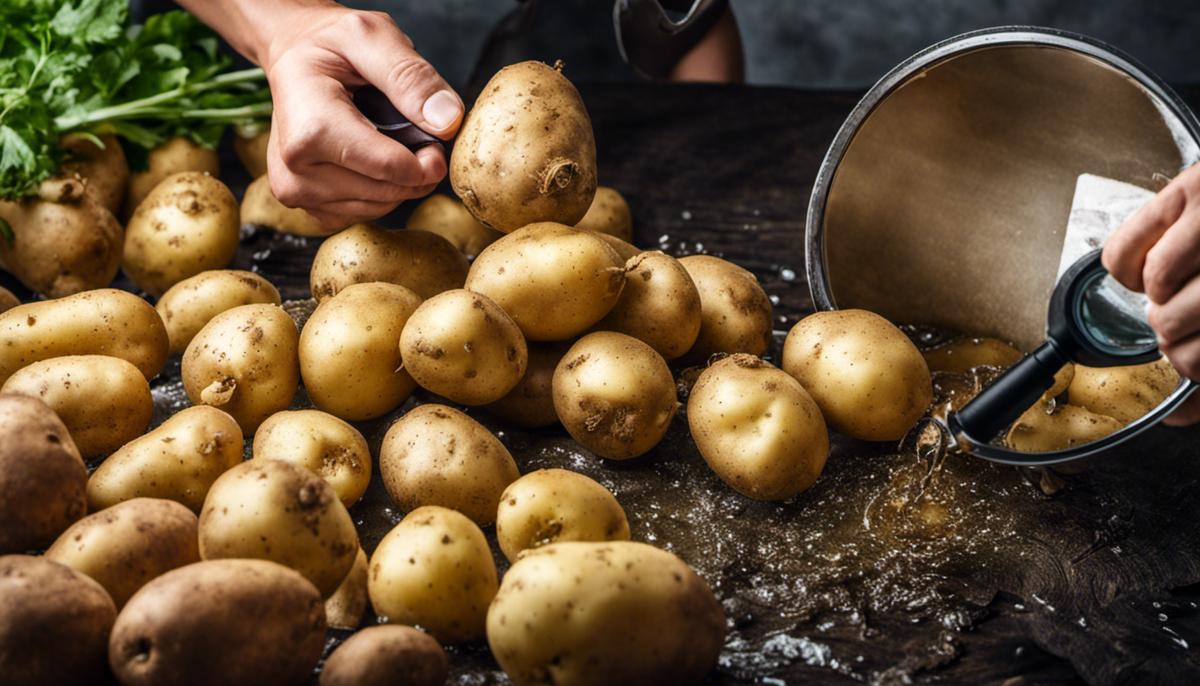DIY: Grow Your Potato Plant in Water

Growing your own food is an empowering and fulfilling activity, and potatoes, with their robust nature and diverse varieties, make an excellent choice for home planting. The process of growing a potato plant in water is both simple and fascinating, allowing you to observe a seed’s journey into a full-fledged plant. This guide will walk you through selecting and preparing the right type of potato, setting up your potato in water, and caring for your sprouting potato plant. Be prepared to delve into the detailed aspects of this exciting gardening project, from understanding the varieties of potatoes suitable for water growth, learning the toothpick method, maintaining the water level, to getting familiar with potato care providers such as sunlight needs and water changing techniques. Let’s immerse ourselves in the magical world of potato growing and harvest the fruits of success along the way.
Selecting and Preparing the Potato
Unearthing the Perfect Potato: A Guide to Selection and Preparation for Budding Spud Specialists
When it comes to hobbies that reward dedication and patience, gardening stands tall like a sunflower in full bloom. The pride stirred up by nurturing diminutive seeds into thriving plants carries an unmatched joy. The specific realm of potato cultivation takes the charm of gardening to a whole new level. But where do you start? The key lies in the selection of the right potato and its precise preparation for planting.
Selecting the Right Potato:
The journey of a thousand potatoes begins with a single spud. While any potato can be planted, certified disease-free seed potatoes are your best bet for optimized yield and quality. A seed potato isn’t a seed in the conventional sense. Instead, it is a mature potato that you plant in order to grow more potatoes just like it.
Choose seed potatoes that are roughly the size of a hen’s egg, but remember, size isn’t everything. Smaller seed potatoes can produce just as bountiful a harvest as their larger cousins. Make sure each potato possesses at least 2-3 strong eyes—the tender sprouts from which new potato plants grow.
When it comes to potato varieties, the world is your oyster. Yukon Gold potatoes deliver a buttery taste and gorgeous gold hue, delightful in any dish. Russets are the all-American classic, perfect for fluffy baked potatoes. For something a little different, try planting the fingerling or purple variety.
Preparing the Potato for Planting:
Once you have your potato, it’s time to prepare it for planting. But before you skip to the digging, it’s important to note a vital step in potato preparation: chitting.
Chitting, or sprouting, involves placing your seed potatoes in a cool, well-lit area away from direct sunlight about 4-6 weeks before planting. This process encourages strong, short sprouts that give your potatoes the best head start when it’s time to meet the soil.
First, lay your potatoes out, eyes facing upwards, in a tray or egg box. Then place the tray in an area with a temperature ideally around 50 degrees Fahrenheit. Most importantly, make sure your eyes are sprouting before you plant.
Once the sprouts are about 3/4” to 1” long, it’s time to plant. Cut larger potatoes into pieces about 2” across, each containing at least one or two eyes or sprouts. Smaller spuds can be planted whole. After cutting, let the pieces sit at room temperature for a few days. This allows the cut sides to dry and form a protective layer, reducing the risk of rot.
Finally, pick a sunny spot in your garden to give your potatoes their new home. Plant the potato chunks about 4 inches deep, with the sprouts facing upwards. Space them about one foot apart in rows, and cover them with soil. Remember, potatoes are eager growers and will break through the soil quickly, so be ready to heap soil around the emerging shoots.
Potato gardening might not be everyone’s cup of tea, but there’s definitely something downright exciting about pulling your home-grown spuds out of the soil. Follow these steps, nurture your plant with love, and enjoy the anticipation of a budding potato harvest, the joy of the patient gardener.

Potato Plant Set Up in Water
The Ultimate Guide to Growing Potatoes in Water
Setting up a potato plant in water introduces a thrilling dimension to our shared hobby. While it might sound like a complex task, it’s fundamentally a straightforward process once you understand the simple steps. Here’s your foolproof walkthrough to setting up your potato plant in water.
The first essential step involves ‘Green Sprouting’, an ingenious water-based sprouting process that accelerates your potato’s sprouting period. You’ll need a jar or vase with a wide mouth, some water, and toothpicks for support. Insert three or four toothpicks around the mid-section of your sprouted potato and suspend it in the jar, where about half or one-third of the potato is submerged in water. Ensure the sprouts or ‘eyes’ are composedly pointing upwards. Be sure to use room-temperature water and avoid excessive sunlight exposure during this step.
Remember, warmth plays a big role in the growing process of your potato plant, and the water where it’s submerged needs to be replaced every other day. This keeps away potential environmental contaminants and provides fresh nutrients to the potatoes. Protect your potato plant from being frozen or exposed to frost, ensuring it stays at a consistent temperature of around 60-70 degrees Fahrenheit.
It’s highly crucial you monitor your potato plant’s growth. It takes about two weeks for the sprouts to become visible from the eyes of the potato and possibly several weeks before they start growing. Patience is your best friend here. As the plants mature, you’ll notice shoots and small green leaves sprouting, marking a milestone in the water-growing journey.
Now let’s discuss lighting! Light plays an inescapably central role in this process. You’ll want to put your potato near a sunny window. Allow it to absorb a good dose of sunlight for at least 6 hours every day. Direct sunlight is preferred, but bright, indirect light can work too.
Also, maintaining the pH level of the water between 5.0-6.0 is crucial for optimal growth. So, regularly testing the water and adjusting the pH could dramatically improve your potato plant’s health. If your water’s pH level is too high, consider adding some vinegar to lower it. If it’s too low, a touch of baking soda can raise it slightly.
Moreover, using a water-soluble potato fertilizer regularly can provide your growing potato with necessary nutrients. Potassium and Phosphorus hold significant importance for the potatoes and should be adequately supplied through water.
When you see your potato plant beginning to flower, anticipate a sizeable harvest pretty soon. The flowering phase is a telltale sign that your potato tubers are growing. Once you start seeing the plants turning yellow and dying off, prepare for harvesting!
Water-growing potatoes might seem unconventional, but it’s a unique and rewarding experience! With these steps, you’re well equipped to start your own water-based potato garden and experience the pleasure of growing your own potatoes. So, go on, dip your toes (or potatoes) into the water and watch them thrive! Happy Farming!

Caring for your Growing Potato Plant
Hydroponics is revolutionizing indoor gardening, and you can be a part of this exciting movement too. Potato cultivation isn’t exclusive to the traditional soil; you can nurture these earthy delights in water as well!
As you dive into the watery world of hydroponic potatoes, it’s essential to know that they are susceptible to some diseases. Don’t fret, though; combining 1 Qt. of warm water with 1 tsp. of hydrogen peroxide should do the trick. Cleanliness is key when dealing with hydroponics.
The next step is positioning the sprouts. Place toothpicks in the sprouts to prevent them from dipping below the water surface. Fully submerged potatoes run the risk of rotting. Make sure to replenish the water repeatedly so it does not get stagnant and continues supplying essential nutrients to the plant.
Speaking of nutrients, it’s time to talk fertilizers. An ideal water-soluble fertilizer should coalesce nitrogen, phosphorous, and potassium. Look for a fertilizer that offers a balanced N-P-K ratio of about 20-20-20. Don’t forget to change the water and replenish the nutrients every couple of weeks.
Lighting is non-negotiable. A location with abundant natural light is advisable. If such a spot isn’t a luxury you possess, then fluorescent grow lights make a great alternative. They closely mimic the sun’s spectrum and stimulate photosynthesis.
Don’t forget to account for temperature! Potatoes fair best in temperatures ranging from 45-80ºF. Consistency in temperature will promote steady growth.
As weeks go by and your potato plant begins to flower, it’s a signal that harvest time is close. Don’t rush the process. Patience will repay with a fuller harvest.
While hydroponic systems require careful attention, the reward of a fresh, crunchy tuber is well worth it. Plus, they are a living testament to the miracles science has brought to our doorsteps. Isn’t it a joy to transform a simple kitchen scrap into a source of sustenance? to watch life grow before our eyes. Embrace the journey of tending to a potato plant in water. It’s not just about the destination (the harvest), but the knowledge, experience and fulfilment that come with the process. And before you realize it, you’ll be a true hydro-pon-tato!
High water, onwards! Happy growing!

The fascinating journey we embarked upon, which starts by selecting the correct potato, setting it up in water, and concludes with taking care of it diligently, showcases the resilient and robust nature of potatoes. Their growth process is a miraculous transformation from a modest vegetable into a thriving plant, gracefully surviving against odds, showcasing a lesson of resilience and adaptability. Exposing your potato plant to proper sunlight, changing the water regularly, and proactively guarding against potential problems can help it thrive. Nurture your plant, and it will reward you with an abundant harvest. So don’t just read about it, get hands-on experience, and start growing your potato plant in water today!



